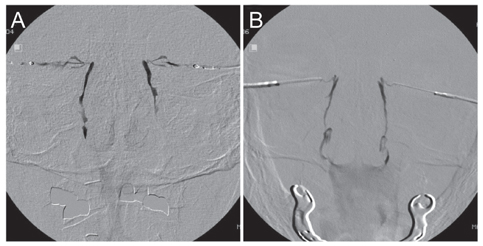Korean J Ophthalmol.
2019 Feb;33(1):95-96. 10.3341/kjo.2018.0113.
Nasolacrimal Duct Stenosis after Oral Capecitabine Administration
- Affiliations
-
- 1Department of Ophthalmology, Seoul National University Hospital, Seoul National University College of Medicine, Seoul, Korea.
- 2Department of Ophthalmology, Seoul National University Bundang Hospital, Seoul National University College of Medicine, Seongnam, Korea. resourceful@hanmail.net
- 3Department of Internal Medicine, Seoul National University Bundang Hospital, Seongnam, Korea.
- 4Department of Ophthalmology, Seoul National University Boramae Hospital, Seoul National University College of Medicine, Seoul, Korea.
- 5Department of Ophthalmology, Seoul National University Hospital, Seoul National University College of Medicine, Seoul, Korea.
- KMID: 2434310
- DOI: http://doi.org/10.3341/kjo.2018.0113
Abstract
- No abstract available.
Figure
Reference
-
1. Mansur C, Pfeiffer ML, Esmaeli B. Evaluation and management of chemotherapy-induced epiphora, punctal and canalicular stenosis, and nasolacrimal duct obstruction. Ophthalmic Plast Reconstr Surg. 2017; 33:9–12.
Article2. Sasaki T, Miyashita H, Miyanaga T, et al. Dacryoendoscopic observation and incidence of canalicular obstruction/stenosis associated with S-1, an oral anticancer drug. Jpn J Ophthalmol. 2012; 56:214–218.
Article3. Noguchi Y, Mitani T, Kawara H, et al. A case of lacrimal duct obstruction caused by capecitabine. Gan To Kagaku Ryoho. 2015; 42:123–125.4. Eiseman AS, Flanagan JC, Brooks AB, et al. Ocular surface, ocular adnexal, and lacrimal complications associated with the use of systemic 5-fluorouracil. Ophthalmic Plast Reconstr Surg. 2003; 19:216–224.
Article5. Prasad S, Kamath GG, Phillips RP. Lacrimal canalicular stenosis associated with systemic 5-fluorouacil therapy. Acta Ophthalmol Scand. 2000; 78:110–113.
- Full Text Links
- Actions
-
Cited
- CITED
-
- Close
- Share
- Similar articles
-
- Silicone Intubation and Dacryocystographic Finding in Incomplete Nasolacrimal Duct Obstruction
- The Methods of Insertiong the Root-type Lacrimal Tube and an Artificial nasolacrimal duct into the Men's
- Success Rate of Silicone Intubation Between Nasolacrimal Duct Obstruction and Stenosis According to Dacryocystography
- Two Cases of Nasolacrimal Duct Cyst Developed in Neonate
- A Case of Nasolacrimal Duct Obstruction after Two-Jaw Surgery


